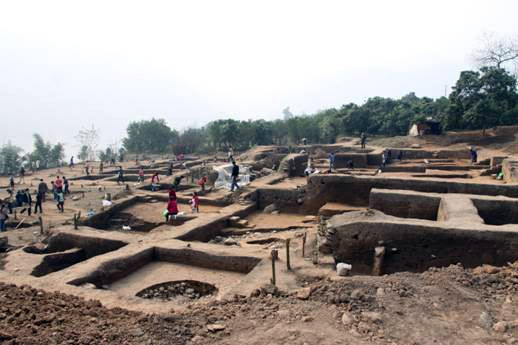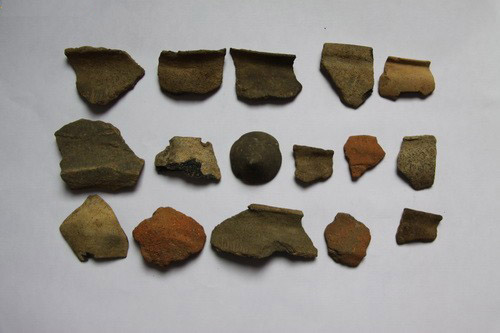Excavation of the Shizhudi Cemetery in Yibin, Sichuan Province
The Shizhudi cemetery, located on the first to fifth terraces on north bank of Jinsha River, administratively belongs to Tianba Village, Loudong Township, Pingshan County, Yibin City, Sichuan Province. The site was discovered in 2006 Archaeological Survey in the Xiangjiaba region. A systematic coring conducted by Sichuan Provincial Archaeological Institute in May 2011 found cultural deposits from the Neolithic and Shan-Zhou periods in the cemetery. Two excavations, covering an area of 4,000 m², have been carried out respectively at Location I from May to August and Location III from November to December.
The excavations yields over 280 relics of various kinds ranging from the Neolithic, Shang-Zhou, Han to Ming-Qing periods, and thousands of miscellaneous objects such as bronze wares, ceramics, irons and stone objects.

Remains from the Neolithic period include postholes of 3 houses and 5 ash pits. Since no foundation trench had been found, it seems that the houses might have been square stilt-style constructions built on the ground For instance, the house site F2 in Location III, has an area of 7 m², measuring 3 m long from north to south and 2.2 m wide from east to west. It has 14 pillar pits measuring 12-28 cm in diameter and 29-40 cm in depth. Within the pits remains grayish-brown sandy earth. Unearthed objects are mainly ceramic and stone objects. Ceramics include sandy and clay earthen wares, with the sandy wares in the majority. Their colors include yellowish brown, reddish brown, blackish brown, grayish brown and gray. The observed forms include cord-marked jars with a curved mouth with a wide everted rim, vessels with a plate-shaped mouth, jars with a flared mouth with an everted rim, as well as lids, ring-foot objects and fishing net weights. Ceramic decorations are cord-marked and fine-cord pattern, applied and incised designs. Stone object are mainly polished tools like stone chisel.
The Shang-Zhou period remains include 5 houses, 1 tomb and 80 ash pits. All houses are constructed on ground, falling into two categories: 1. Buildings with foundation trenches and pillar pits. There is only one house of this kind, in a poor state of preservation. Only the foundation trench for the east wall and a part of south wall could be seen, with the rest destroyed by Han Dynasty tombs; 2. Stilt-style buildings, remaining only pillar pits and without foundation trench. As to their plans, two are nearly square and one is oval and one is triangular.
The tomb is in a shaft form remaining 2 m long and 0.62 m wide, filled with yellowish brown earth. The skeleton is poorly preserved. Very few burial objects are found. Only two jars with pointed bottom could be identified.
The ash pits are in various forms like oval, round, square, rectangular and irregular shapes.
The unearthed objects are mainly ceramics and stone wares. Ceramics are mostly sandy earthen wares. There are also some clay ones. Ceramic colors include grayish-brown and red. Their surfaces are plain or marked with cord pattern. The visible forms include point-bottomed jars, point-bottomed cups, round-bottomed bowls, point-bottomed plates, small flat-bottomed jars, vessels with a high neck, vessels with a ring-foot, fishing net weights and spinning wheels. Stone objects, like stone axes and awls, are mainly polished ones, and there are also some chipped ones.

Remains from the Warring States and Qin-Han periods include 61 tombs and 30 ash pits. The tombs are assigned to the late Warring States period to middle and late Eastern Han Dynasty. With a well-planed distribution they vary in forms as rectangular shaft, round pit, brick-constructed, stone cist and urn burial.
Burial objects include wares of ceramic, iron, bronze and stone. Ceramics are mainly sandy earthen wares, in colors of gray, grayish brown, blackish brown, red and yellowish brown. The visible forms include jars, urns, Zengs, cauldrons, Dous and single-eared jars. Other objects include bronze wares like coins, lances and fragmentary mirrors, iron wares like swords, axes, forks, and some agates beads.
Nearly 70 features are assigned to Ming-Qing dynasties, including houses, ash pits and tombs. Tombs are mainly rectangular shaft and stone cist. Ash pits are in oval, round and irregular forms.
The Shizhudi Cemetery is a Han period cemetery with a wealth of findings in southern Sichuan Province. The two excavations help to make clear the distribution laws and cultural traits of the cemetery, and provide important materials for studying cultural exchanges between southern Sichuan and the reaches of Jinsha River during the Qin-Han period. The large-sized Shang-Zhou ruin is considered to be the first discovery of its kind in southern Sichuan. The Neolithic remains are of great significance for researching origin of the Neolithic culture in the reaches of Jinshajiang River and its mutual relation with Baodun Culture in Chengdu Basin and Neolithic cultures in Three Gorges areas. (Translator: Tong Tao)

